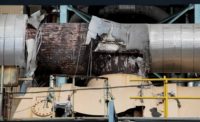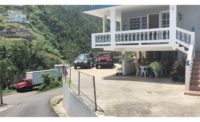Assessing the Damage in Puerto Rico

After the Storm The U.S. Army Corps of Engineers has focused on reaching and assessing critical infrastructure (above) while the rest of Puerto Rico copes with damaged buildings and crippled power transmissions systems. Photo courtesy USACE

After the Storm The U.S. Army Corps of Engineers has focused on reaching and assessing critical infrastructure while the rest of Puerto Rico copes with damaged buildings (above) and crippled power transmissions systems. Photo by Luke Abaffy for ENR

After the Storm The U.S. Army Corps of Engineers has focused on reaching and assessing critical infrastructure while the rest of Puerto Rico copes with damaged buildings and crippled power transmissions systems (above). Photo by Luke Abaffy for ENR



Many Puerto Ricans are living without reliable power, water and cellular coverage as the U.S. Army Corps of Engineers implements a temporary relief system for critical infrastructure and works to stabilize the spillway of a hurricane-damaged dam.
“We have 2,400 miles of transmission lines and 30,000 miles of distribution lines in Puerto Rico. The Puerto Rican Electric Power Authority [PREPA] estimates that 80% of those are destroyed,” says Jose Sanchez, director of contingency operations and homeland security for the Corps. “We have 30 substations, and some haven’t been able to be assessed due to the location and lack of communication.”
Traversing the storm-ravaged island isn’t only impeding Corps teams’ ability to assess damage to facilities such as hospitals and shelters, it also is hindering an emergency mission: the stabilization of Guajataca Dam, a 984-ft-long, 120-ft-tall hydroelectric earthen dam damaged by the storm.
Emergency Operations
After the hurricanes, the volume of water flowing through Guajataca Dam’s 646-ft-wide spillway was so immense that it undercut and eroded the spillwall. The Corps is providing Dept. of Defense resources to stop the erosion below the spillway, says Col. James A. DeLapp, commander for the Corps recovery field office in Puerto Rico.
“The roads are basically cut off,” says DeLapp. “You can’t get trucks down there to push rubble in because it’s still spilling water.”
When the Corps arrived at the island, the Federal Emergency Management Agency commissioned it to support PREPA, which owns and maintains the dam. “We brought some of our dam-safety engineers out to take a look at it, and we came up with a plan of emergency action to stabilize it,” says DeLapp.
The team developed plans “to reduce the erosive conditions, and materials were transported to Puerto Rico on military aircraft,” says Stephen Duba, dams and levees engineer for the Corps, assigned to the Puerto Rico recovery field office. “As erosion continued and site conditions changed, the plans changed to directly armor the remaining spillway through placement of concrete barriers using heavy-lift air assets.”
Once the barriers are in place, they will be followed by large sandbags and riprap to armor the channel and limit the rate of erosion, says Duba. If the stabilization process is successful, the next step will be to install large pumps near the crest of the embankment in an effort to draw the reservoir level below the spillway crest to allow for more extensive repairs.
“The success of these steps is contingent on the amount of rainfall that occurs within the dam’s drainage basin,” says Duba. “The risk of failure is still high.”
DeLapp says each DOD service branch is supporting the operation. “The Army, Navy and Marines are flying in Jersey barriers and dropping them in place. And the Air Force is flying in pumps to take pressure off the dam,” he says, adding that no further assessment of the damage beneath the spillway can be performed until the flow of water through it is cut off.
Reestablishing the raw-water supply from the dam reservoir is another high-priority task, says Duba. The storm’s force eroded the spillway, cutting local residents’ freshwater supply, and the channel is now blocked with debris. Work is underway to clear the channel and restore an uninterrupted flow as soon as possible.
‘Prime Power’ Targets Critical Systems
Aside from emergency dam stabilization, FEMA relies on the Corps in disaster response to provide solutions for debris removal, damage to infrastructure, temporary housing, roofing and power.
One piece of critical infrastructure is Hospital Pavia, in Arecibo, which lost power during the hurricane.
“The temperatures from the third floor and higher range from 110°F to 120°F,” says Sgt. 1st Class Anthony E. Persina, a member of the 249th Engineer Battalion, known as Prime Power. The unit is managing generator installations across the island. The Corps is installing a 1-MW and 2-MW generator to get Hospital Pavia’s chiller plants and air-handling units back on line.
Power restoration cannot come too soon for the hospital’s paramedics. “We took patients out of the ER and moved them into air-conditioned tents,” says Jeff Counts, lead health tech and intermittent employee for the Dept. of Health and Human Services, pointing at the newly constructed tents outside the hospital. Even after grid power was reinstated at the hospital, it wasn’t reliable enough to resume full operation. “We were having a meeting in the hospital last night, and one or two transformers popped off,” says Counts, whose team will move on to the next hospital in Puerto Rico after the generators are up and running at Hospital Pavia.
Amid the flood of federal employees working to rebuild the island, Puerto Ricans are hard at it, as well. Trees, plucked up by their roots or snapped in half by the hurricane, are being cut up by local residents and stacked on the sidewalks of San Juan. Dead and fallen power lines are being propped up with whittled branches so that cars can drive beneath.
“I’ll have no rest for a long time,” says Edward Rivera, a PREPA lineman, with the help of a translator. Rivera and his team just finished installing and wiring up six power poles and now await cable to get at least one block of San Juan back on the grid.
“I don’t know when I’ll have a normal life, but I’m very proud to help restore power,” says Rivera.
Related Article: Technology Firms Offer Aid to Puerto Rico








